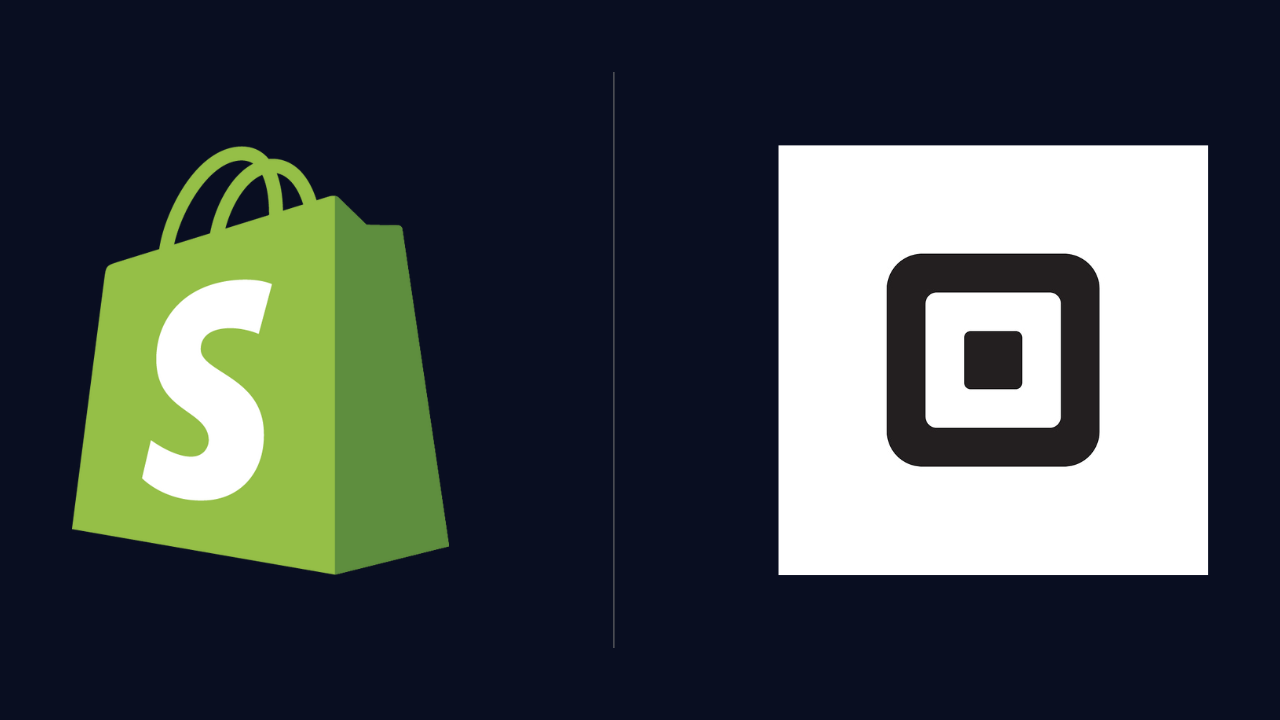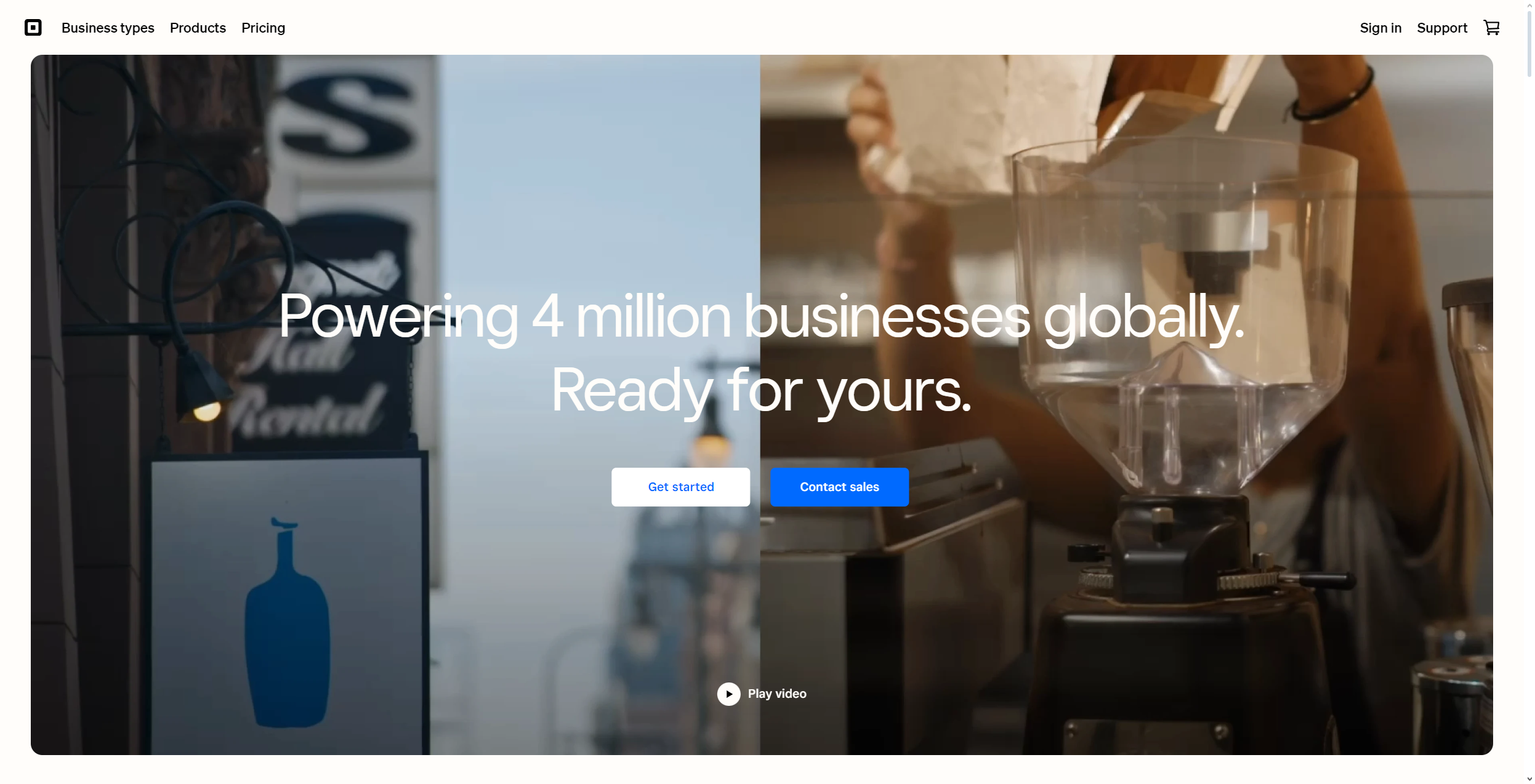Shopify vs Square: Which is best for ecommerce?
A head-to-head between two leading ecommerce platforms

Shopify is well established as one of the best ecommerce platforms thanks to its all-in-one comprehensive digital commerce tool kit. Today, the platform powers more than five million merchants globally with advanced capabilities in customization, inventory management, and integration with hundreds of the best payment gateways. Shopify offers everything from simple online shops to enterprise-level ecommerce solutions with robust marketing and a large app marketplace, starting at just $39/month.
Square started as a mobile payment solution, but has become a major ecommerce player with its one-click website builder and payment processor. It's also unique in offering one of the best free website builder plans as its foundation with a simple pricing scheme on top of it, making it especially appealing to smaller companies and brick-and-mortar stores creating online shops. With integration between physical and digital sales channels, Square performs better when it comes to the essential inventory management system and basic marketing tools.
Although both platforms target the ecommerce market, they cater to very different groups of online merchants. Shopify appears to be the more comprehensive approach for businesses that primarily focus on online sales. Square, on the other hand, brands itself as the right platform for businesses focused heavily on in-person sales but also requiring a good online presence.
Shopify is a comprehensive ecommerce platform designed for online-first businesses, offering extensive customization and scalability options. The platform serves over a million merchants worldwide with robust features, extensive app integrations, and advanced AI tools for automation and optimization.
For
- Powerful customization options
- Extensive app marketplace
- Advanced AI automation tools
- Comprehensive analytics dashboard
- Multiple payment gateway support
Against
- Higher monthly costs
- Complex advanced features
- Transaction fees unless using Shopify Payments
- Steeper learning curve
- Limited free themes
Square is an integrated commerce platform that seamlessly bridges physical and digital sales channels. The platform offers a free entry-level plan and straightforward pricing structure, making it particularly attractive for small businesses transitioning to online sales.
For
- Free starter plan
- Simple setup process
- Integrated payment processing
- Free card reader included
- Strong offline capabilities
Against
- Limited customization options
- Restricted payment gateway options
- Basic marketing features
- Small app marketplace
- Limited international features
Feature | Shopify | Square |
|---|---|---|
Starting Price | $39/month | Free basic plan |
Transaction Fees | Starts at 2.4% + 30¢ | Starts at 2.6% + 10¢ |
Payment Gateways | 100+ options | Square Payments only |
Themes/Templates | 100+ themes (free & paid) | Limited themes |
Product Variants | Up to 100 per product | Up to 250 per product |
Inventory Management | Robust features | Essential features |
Marketing Tools | Extensive marketing suite | Basic marketing tools |
Customization | Highly customizable | Limited customization |
Shipping Discounts | Up to 88% | Up to 55% |
Customer Support | 24/7 AI-first support | Mon-Fri phone support |
Dropshipping | Supported | Not supported |
App Marketplace | 6,000+ apps | 300+ integrations |
Hardware Options | Sold separately | Free card reader included |
Abandoned Cart Recovery | All plans | Plus and Premium plans only |
Multi-location Support | Up to 5 locations | Up to 300 locations |

Shopify vs Square: Features
Shopify is an all-in-one ecommerce beast with a range of built-in ecommerce features. It includes unlimited products, strong inventory management, and integration with over 100 payment gateways, allowing more flexibility to create a business that fits you perfectly. An expansive app marketplace with over 6,000 integrations lets merchants extend functionality in just about any direction, while built-in tools like abandoned cart recovery, automatic tax calculations, and multi-currency support come as standard.
Square comes at features from a distinct perspective, with its focus on how online and offline sales can bridge together. Unlike Shopify, which only allows 100 variants, the platform allows you to list unlimited products with up to 250 product variants per item. Features like inventory tracking, local delivery options, and basic marketing tools are included in the Square free plan, but advanced functionality like abandoned cart recovery is only available on higher-tier plans.
Shopify is better equipped for pure ecommerce, offering one of the best website builders for online shops. But, Square shines at unifying physical and digital sales, even if it misses out on dropshipping support. That said, both platforms offer inventory management and point-of-sale integrations.
Shopify vs Square: Ease of use
Shopify has a clean, easy-to-navigate front end and a thorough onboarding process, with step-by-step instructions. Its dashboard is laid out logically, enabling easy navigation of the different sections like Orders, Products, and Marketing - although some advanced customization options may need technical knowledge or professional help.
Square adopts a more simplified view of store set-up and does most of the technical heavy lifting for you automatically. With its drag-and-drop editor, changes to store elements are made instantly, allowing for more flexibility than the section-based editor of Shopify. Setup is simple and requires minimal input - enter business details, pick features, and upload a logo.
While both perform well in the various user experience categories, Square does pull slightly ahead in the ease with which you can set it all up. But do note that Shopify comes with more powerful features and customization capability, in exchange for a steeper learning curve. Square makes no pretenses about it and chooses to get businesses up and running without delay, appealing to merchants that require limited customization.
Shopify vs Square: Customer support
In 2025, Shopify redesigned its entire customer support model for their Help Center, transitioning from using conventional phone & email customer support to AI. AI now acts as a first point of contact for all support queries, such as creating support tickets and offering instant answers for common questions. You can only access human support advisors for complex issues after interacting with the AI assistant. However, the system is available 24/7, which can be useful for merchants in different time zones.
Square has a traditionalist multi-channel support approach but with caveats. Support is offered via email and live chat, and the staff monitors all questions during business hours. One of the strongest advantages of Square over other services is that they offer a free card reader and include basic support with any of your plans, making them a great option for small businesses. The platform also provides a wide array of self-service resources on their Support Center, with in-depth articles and video tutorials.
On one hand, Square provides direct human interaction, but its hours are limited. On the other hand, Shopify is available at all times with an AI-first approach. While they both have a large amount of self-help resources available, Shopify's move towards AI-driven support could pose a learning curve for merchants used to traditional support channels.
Shopify vs Square: Security
Shopify uses SSL encryption, DDoS attack protection, and stiff PCI compliance standards to maintain safety. In 2025, the platform introduced a series of security enhancements, including an improvement in 2FA and an update to the hCaptcha-based challenge, moving away from the security of using reCAPTCHA. This ensures that the merchants using this platform do not have to worry much about security updates and patches, as the platform takes care of it all automatically.
Shopify simply takes care of the security for you, implementing the latest in fraud prevention tools that provide real-time analysis and risk assessment for every order. The platform, however, requires some technical knowledge for effective implementation, as it allows to customize security settings extensively.
Square implements a security approach that focuses on securing merchants and customers alike; encrypting payment information and implementing monitoring systems. All payment information (whether via chip and pin, magstripe, or contactless payments) is encrypted by the platform at the time of the transaction. Square's infrastructure is located in highly-secure facilities monitored by dedicated security staff 24/7 with full PCI-DSS compliance.
Square offers built-in fraud prevention and transaction monitoring through an integrated system, a feature it calls “security by integration.” Square's custom algorithms automatically identify and freeze suspicious activity, growing in effectiveness as its user base expands. But, a strong technical team is required on the merchant side to set up a secure solution.
Both platforms take security seriously, but in different ways. Shopify gives you customizable security options with more advanced features. Square has a more streamlined, automated security system. For merchants, it may be down to whether they prefer Square’s easier security management or Shopify’s more configurable but harder to set up security infrastructure.

Shopify vs Square: Tools, add-ons, and extras
Shopify has transformed its platform through AI-powered automation tools that simplify operations for merchants. Shopify Magic is the overarching AI suite, assisting in creating SEO-friendly content, product descriptions, and marketing materials - all while upholding brand voice consistency. New features, including an updated search experience, faster load times, and enhanced analytics tools, were debuted in the platform's Winter 2025 release with over 150 feature enhancements.
With over 6,000 apps available, Shopify's app ecosystem gives merchants access to powerful customization features and specialized tools for almost any business use-case. Eliminating expensive integrations, their unified commerce approach cuts down on operational complexity and allows retailers to focus on innovating their business.
Square offers practical business tools geared toward merchants, including Square Virtual Terminal for remote billing, Afterpay for purchase payments in installments, and built-in subscription management. They also offer banking services such as Square Checking with a no-fee business debit card, and Square Savings to automatically allocate sales.
10 new generative AI features have been added to automate operations and bring velocity to workflows. Some of the use cases include AI-written menu generators, photo environments for product visualization in eCommerce, and AI agents for customer support. The range of tools available, whether natively or through its vast add-on marketplace, includes email marketing, loyalty programs, team management, and banking services. All of it is priced between $4 per employee for basic tools to $45 per month for more advanced loyalty programs.
Both platforms are investing massively in AI and automation, but they approach extras differently. Shopify highlights an all-around ecosystem focused on integration and customization, while Square take a more narrow and purpose-built approach with business and financial tools that target specific areas of operation.
Shopify vs Square: Hardware
Shopify sells a range of POS hardware, with the Shopify Countertop Kit costing $459 and the Wireless Countertop Kit going for $999. Comprised of tablet mounts, barcode scanners, receipt printers, cash drawers, and other hardware solutions, these bundles provide high-quality tools compatible with both iOS and Android devices.
Square's family of hardware products includes the Square Stand ($149), Square Terminal ($299), and different bundles such as the Square Register Kit ($1,219), all giving you flexible payment options with monthly financing. Recently, they made offline payment capabilities for hardware available to their entire lineup, so that sellers can process transactions even without constant internet connectivity.
Although the two solutions offer full-stack hardware services, their core audiences are different. Shopify positions its hardware around integrated retail operations with large upfront costs into the hardware. Square includes more flexible options to lower the entry point with financing alternatives to enable smaller operations.
Shopify vs Square: Pricing
In 2025, Shopify still maintains a tiered pricing structure with three core plans: Basic Shopify ($39/month), Shopify ($105/month), and Advanced Shopify ($399/month). Basic has the highest transaction fee of 2.9% + 30¢, but the Advanced plan comes with a reduced transaction fee of 2.4% + 30¢ for online payments. The platform includes a 3-day free trial followed by $1/month for three months, with merchants saving up to 25% on an annual payment.
Square is more flexible with its pricing, offering a free basic plan, then Plus at $89/month, and finally Premium with custom pricing. You pay transaction fees starting at 2.6% + 10¢ for in-person payments and 2.9% + 30¢ for online payments, with lower rates available for higher-tier plans. Square has additional services such as email marketing and loyalty programs available as separate add-ons, allowing businesses to tailor solutions to what they really need.
While both platforms take a subscription-based approach, Square offers the most affordable solution for businesses just starting out or on a budget with its free plan and overall straightforward pricing structure. But, Shopify is better suited to expanding businesses which require advanced features and can benefit from volume discounts on transaction fees.
Shopify vs Square: Final verdict
The unending Shopify vs Square debate ultimately boils down to your business' growth trajectory in 2025. Shopify attracts serious ecommerce operations because it offers the most scalability and customization, with a powerful app ecosystem fit for serious growth. On the other hand, Square might be the better choice for businesses that value in-store sales or are new to going online, thanks to a free plan and offline payment processing.
Are you a pro? Subscribe to our newsletter
Sign up to the TechRadar Pro newsletter to get all the top news, opinion, features and guidance your business needs to succeed!

Ritoban Mukherjee is a tech and innovations journalist from West Bengal, India. These days, most of his work revolves around B2B software, such as AI website builders, VoIP platforms, and CRMs, among other things. He has also been published on Tom's Guide, Creative Bloq, IT Pro, Gizmodo, Quartz, and Mental Floss.
You must confirm your public display name before commenting
Please logout and then login again, you will then be prompted to enter your display name.